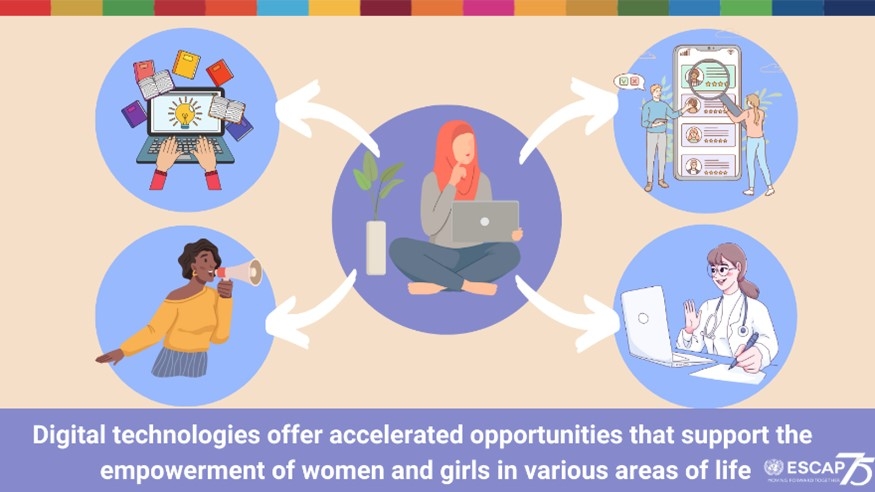
At the heart of the 2030 Agenda and the Sustainable Development Goals (SDGs) is the aim to eradicate poverty, realize human rights for all; achieve gender equality and the empowerment of all women and girls; and ensure lasting protection of the planet and its natural resources. The achievement of gender equality and the empowerment of women and girls is laid out under SDG5. To improve and promote gender equality and women’s and girls’ access to opportunities, target 5b sets out to ‘enhance the use of enabling technology, in particular, information and communication technologies (ICTs), to promote the empowerment of women’.
If utilised effectively, digitalisation can contribute to the achievement of gender equality - equipping women and girls with a wider range of skills and opening opportunities that support their economic empowerment. Mobile phones, the internet, social media and other digital platforms, as well as digital financial services, can offer diverse gateways to helping women increase their employability and employment prospects, earn additional income, and expand webs of knowledge and information. Additionally, embracing and using digital technology can provide women and girls with chances to overcome obstacles they may face in the physical world. Digital access empowers women to grow in confidence, foster civic engagement and enhance understandings of their rights. Women in Iran, for instance, have observed social media to be a neutral zone where they may express themselves when they couldn't otherwise, and a place where they can start discussions that would be taboo in other contexts.
The digital world gives us the ability to access information and increase our knowledge on any topic of interest. For those with access, using a search engine to get the answer to any kind of query is probably second nature. Just think about how much more challenging your life would be and how much less you would know about the world and the opportunities accessible to you if you were unable to access to the benefits given by the digital world and its technologies.
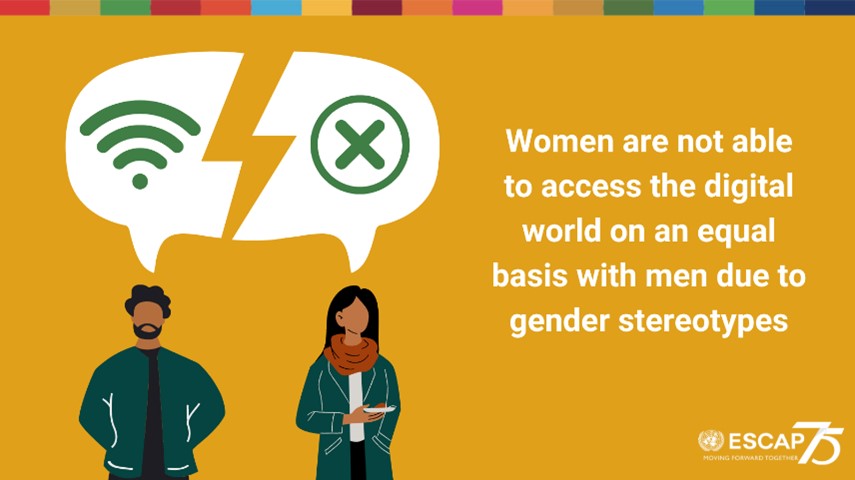
Social barriers
However, widespread beliefs that the digital sphere is a "man domain," reinforced by entrenched gender biases and socio-cultural norms, restrict women and girls in the Asia Pacific region from fully participating in the digital world. Lack of online safety, which increases the likelihood of harassment and abuse, perceptions of occupations in the STEM fields as intrinsically masculine, a lack of affordable technology access, and an absence of digital skills and training all contribute to and perpetuate these stereotypes.
Digital gender divide in Asia and the Pacific
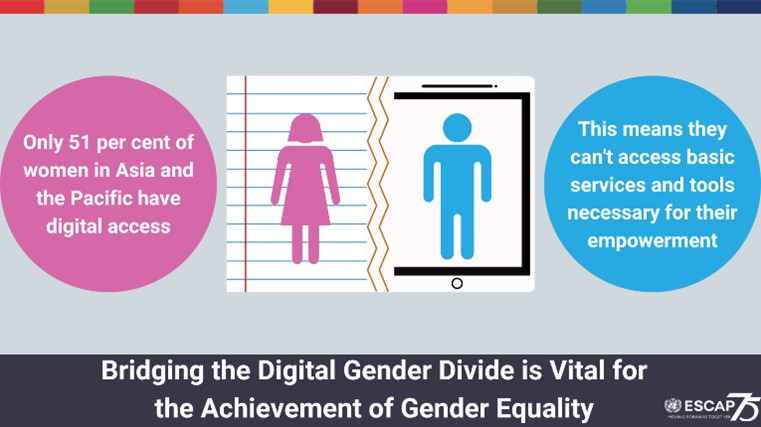
As a result, the International Telecommunication Union (ITU) has found that there is a digital gender divide wherein only 57 per cent of the total global female population use the Internet, compared to 62 per cent of the global male population.
Access to the digital world is even lower in Asia and the Pacific, where only 54 per cent of women use the internet compared to 59 per cent of men. That means 46 per cent of women are without access to the basic services and tools necessary for their empowerment.
Mobile Phone Access
This digital gender gap is evidenced in many ways, one of which is the varying access to mobile phones. According to the Internet Society more than one third of the population in Asia-Pacific uses the mobile phone as the primary means to access the internet. Mobile phone access is increasingly important in today’s society granting vital access to information, services and opportunities. Research on female mobile phone ownership has been shown to promote sexual and reproductive health since it provides women easy access to information that may be hard to otherwise obtain in certain Asian and Pacific countries.
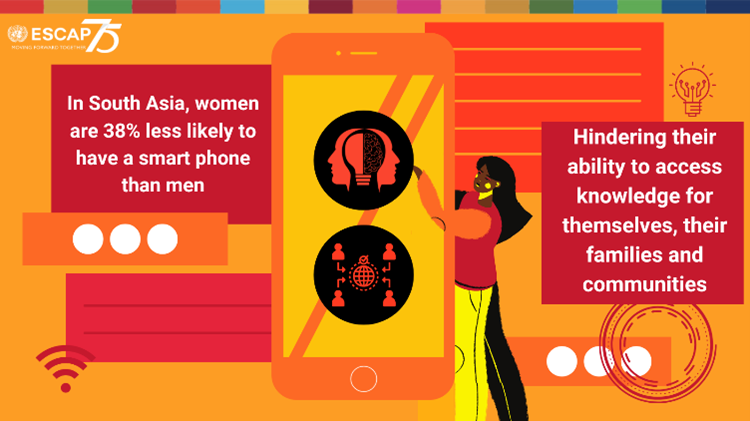
Despite this, women across Asia and the Pacific are considerably less likely than men to own a mobile phone, with data from ASEAN showing that women in South Asia being 38 per cent less likely to own a mobile phone massively impacting on their ability to access vital knowledge and services.
Gender Divide in STEM
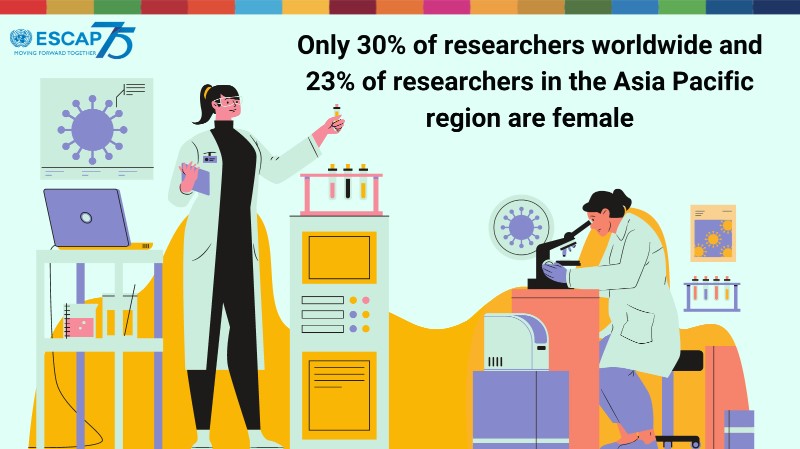
When looking at women's participation in STEM (science, technology, engineering, mathematics) disciplines in the workforce and in higher education, the gender gap becomes even more pronounced. UNESCO data shows that only 30 per cent of the world's researchers are women, in Asia and the Pacific that figure is 23 per cent. Research also shows that of all students enrolled in STEM subjects globally, only 35 per cent are women and for every new STEM-related job, women get only one job while men gain five.
While the gender gap in internet and mobile phone use is seen everywhere, the gap in science, technology, engineering, and math is even more widespread. Men are more likely to pursue and succeed in STEM fields than women almost everywhere in the world. Looking back on educational experience, it is evident that while boys dominated science, technology, engineering, and mathematics courses in both high school and college, girls were more numerous in the less traditionally “masculine" areas of study including languages, social sciences, and the arts.
This reflects a broader understanding that technologies are created by men for men since STEM and software are dominated by males, creating opportunities for inequality as well as a loss of talent, viewpoints, and possible improvements. With STEM innovations having incredible potential to drive sustainable development, these startling statistics highlight the critical need to increase the representation of women in STEM professions in order to ensure that digital apps and services are tailored to women's needs and priorities in the future.
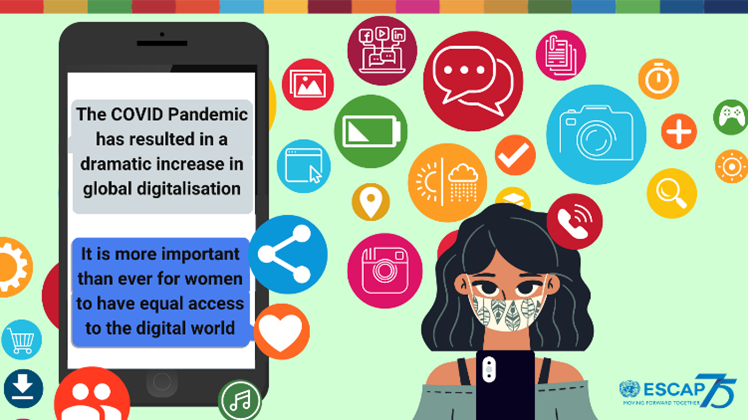
Impact of COVID-19
The COVID pandemic has only served to heighten these existing inequalities. Research shows that worldwide lockdowns, social distancing and other COVID related restrictions saw rates of digitalisation increase by between 40 and 100 percent as many services, both public and private, moved into the digital sphere. Increased levels of global digitalisation have been impactful in creating new opportunities and increased access to more knowledge, goods, and services for those with digital access whilst simultaneously leaving those without behind, thereby further increasing the disparity between the two groups. Inaccessibility to the digital world also hindered the ability of many women in acquiring essential knowledge essential to navigating the pandemic. In Bangladesh and Pakistan, for instance, 15 percent fewer women than men accessed critical information during the COVID-19 epidemic owing to the digital gender barrier.
Promising Practices
Across Asia and the Pacific, various countries and regional bodies have taken measures to try and improve women’s access to the digital sphere and increase their involvement in STEM education and employment.
In 2019, the Asia-Pacific Economic Cooperation (APEC) launched an economic collaboration to address issues related to women's digital skills and to demonstrate the benefits of having women involved in STEM-related work and studies. Women in STEM Principles and Actions focuses on both identifying but also tackling the social, economic and cultural barriers that women and girls face. Women in STEM Principles and Actions are based on three principles: (i) women are recognised as an important part of the economy, innovation and technology, where APEC provides education and mentorship for girls and women in STEM-related areas, (ii) women's participation in STEM increase, advocate and strengthen women and girls, and (iii) identifying measures to create an environment without restrictions and barriers for women in STEM.
Other national programmes include Singapore’s Girls2Pioneers, which provides day camps for girls from disadvantaged and marginalized backgrounds, aged 10-16 to “inspire and encourage youth in Singapore, particularly young girls and women, to explore and consider careers within STEM fields'', and India’s Indian Girls Code, a free hands-on coding, and robotics education programme for underprivileged girls in India.
There have also been numerous women who have been able to overcome the many obstacles women confront and forging strong careers in STEM fields. Many of these women have been able to use their success as a platform from which to encourage further female engagement in the field. The recently established directory STEM Women Asia is a good example of this trend; it features profiles of women working in STEM in 30 different countries across Asia and the Pacific with the goal of serving as a platform to increase the visibility of women in STEM, increase female representation, and give women access to role models and professional networks.
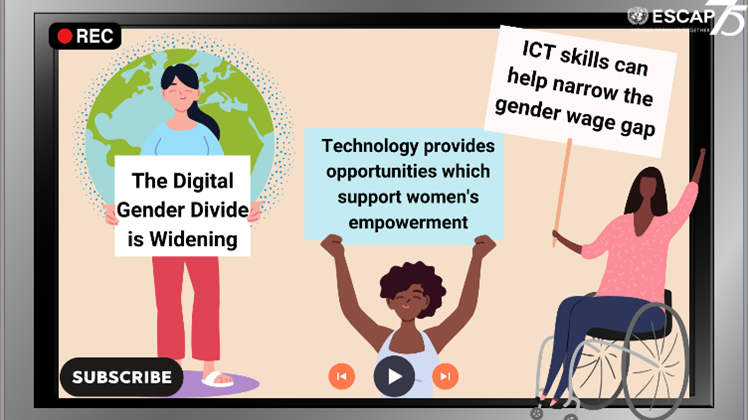
Moving Forward
It is crucial that moving forward, that we all take the measures necessary to ensure that no one is left behind, and offline. Without actively working to give more women and girls access and learn to use digital tools, girls will have fewer employment opportunities and will face even more obstacles to being competitive in an increasingly digital world. Moreover, without access, women and girls miss out on potential ‘leapfrog’ opportunities that can help their empowerment. Only by investing in and implementing policies that encourage women's digital access and participation in the digital world will we be able to achieve a truly inclusive and equal society in which men and women are granted equal rights, opportunities, and freedoms.
 Caroline Crawford
Caroline Crawford
Gender Equality and Social Inclusion Intern

